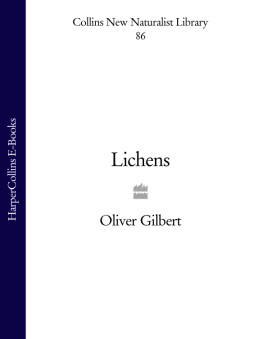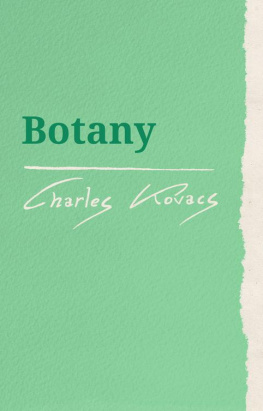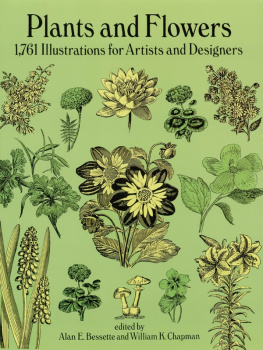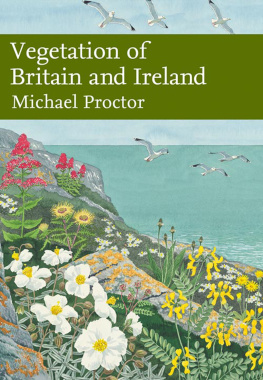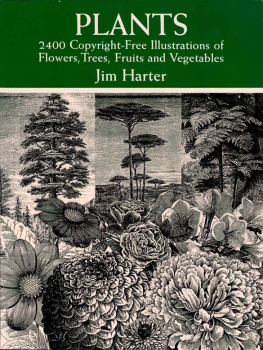Sarah A. Corbet ScD
S.M.Walters, ScD, VMH
Prof. Richard West, ScD, FRS, FGS
David Streeter, FIBiol
Derek A. Ratcliffe
The aim of this series is to interest the general reader in the wildlife of Britain by recapturing the enquiring spirit of the old naturalists. The editors believe that the natural pride of the British public in the native flora and fauna, to which must be added concern for their conservation, is best fostered by maintaining a high standard of accuracy combined with clarity of exposition in presenting the results of modern scientific research.
To Natasha, Kate and Emma
Plate 1
(a) The lichenologist Ray Woods wearing a jersey knitted from lichen-dyed wool (J. Woods).
(b) Lichen dyes. Cudbear (top) produces red dyes and crottle shades of brown (D.J. Hill).
(c) A modern lichen dyer with dye-pot, lichens and treated wool, Strontian.
(d) Central panel of a well-dressing tableau made from petals and several types of lichen, Derbyshire.
(e) Canons Ashby Church, Northamptonshire, showing how lichens enhance architectural detail (D.J. Hill).
Plate 2
(a) The lichen alga Trebouxia growing in culture (The Natural History Museum, London).
(b) Jelly lichens contain the cyanobacterial partner Nostoc (J.M. Gray).
(c) Sticta canariensis green algal morph and S. canariensis cyanobacterial morph contain the same fungus (J.M. Gray).
(d) The fruticose growth form exhibited by a beard lichen (Usnea articulata) pendant to 60 cm (J.M. Gray).
Plate 3
(a) Nest of a long-tailed tit (Aegithales caudatus) decorated with lichen to aid concealment by light reflection (B.J. Hatchwell).
(b) Caterpillar of the light crimson underwing moth (Catocala promissa) mimicking a lichen-covered surface (J. Porter).
(c) Caterpillar of the dotted carpet moth (Alcis jubata) feeding on Usnea (P.A. Ardron).
(d) Autumn green carpet moth (Chloroclysta miata) at rest on a lichen-covered tree trunk (R.W. Barnes).
Plate 4
(a) Thick sward of the pollution-tolerant lichen Lecanora conizaeoides on larch.
(b) Usnea florida, a beard lichen that is highly sensitive to several forms of pollution (J.M. Gray).
(c) Lichens on beech that have been killed by airborne fluorides, Invergordon, Scotland.
Plate 5
(a) Old beech woodland, New Forest, Hampshire (T. Heathcote).
(b) Lobaria pulmonaria festooning mossy Atlantic rainforest, Western Scotland (J.M. Gray).
(c) Atlantic oak woodland above Loch Sunart, Ardgour.
(d) A rich Lobarion community covering a bough at Loch Sunart; the lichen with golden soralia is Pseudocyphellaria crocata (F. Rose).
Plate 6
(a) Parmentaria chilensis, a strongly oceanic species known in Britain from one hazel wood at Loch Sunart (A.M. Coppins).
(b) Hypogymnia physodes, a common species of birch woods in the Highlands (J.M. Gray).
(c) A pin-head lichen, Chaenotheca furfuracea (J.M. Gray).
(d) A writing lichen, Graphis scripta, characteristic of smooth bark (J.M. Gray).
(e) Well-lit, smooth bark on many deciduous trees supports a mosaic of small crustose lichens (J.M. Gray).
Plate 7
(a) Ophioparma ventosum, a lichen of acid rocks (I.C. Munro).
(b) Lasallia pustulata, a gregarious lichen (I.C. Munro).
(c) Purple-stained lichen on quartzite, Foinavon (D. Miller).
(d) Ramalina polymorpha, a species typical of basalt tors.
(e) Damp, north-facing slabs of basalt are home to many rare lichens, Trapain Law, Lothian.
Plate 8
(a) Cladonia coccifera, abundant on acid soils (J.M. Gray).
(b) Cladonia floerkeana, the Bengal match lichen, abundant in acid habitats (J.M. Gray).
(c) Cladonia portentosa, the commonest of the Reindeer lichens (P.A. Ardron).
(d) Close-up of the lichen carpet at Wangford Warren, Breckland.
Plate 9
(a) Lichen-rich chalk grassland has developed where the surface was scraped off in 1940 to form a shooting butt, Martin Down.
(b) Lichenologists inspecting a path on the chalk downs, Butser Hill.
(c) Lichenologists at work on a limestone pavement, Ingleborough.
(d) Synalissa symphorea and Psora lurida on the surface of a limestone pavement, Gait Barrows (J.M. Gray).
(e) Caloplaca aurantia, a species characteristic of Jurassic limestones (T.W. Chester).
Plate 10
(a) Lecanora polytropa growing on iron railings.
(b) Lecanora rupicola thickly encrusting a sandstone tombstone (T.W. Chester).
(c) Rhizocarpon geographicum on a slate tombstone.
(d) Timber-boarded Sussex barn carrying what is believed to be a unique assemblage of rare lichens, Parham Park.
Plate 11
(a) The international community dominated by Lecanora dispersa (white) that is present on concrete (I.C. Munro).
(b) Old open cast workings rich in heavy metals, Parys Mountain, Anglesey (O.W. Purvis).
(c) Baeomyces roseus only fruits regularly at acid mine sites (P.W. James).
(d) Baeomyces rufus is widespread at most acid mine sites (I.C. Munro).
(e) The normally brown Acarospora smaragdula becomes green when growing on copper-rich rocks (O.W. Purvis).
Plate 12
(a) Lower part of the Ben Alder buttress coloured yellow with Fulgensia bracteata.
(b) The rare alpine Lecanora epibryon growing with Salix reticulata, Ben Alder (A.M. Fryday).
(c) Margarets Coffin almost devoid of snow, September 1996.
Plate 13
(a) Solorina crocea has a thallus with an orange underside (I.C. Munro).
(b) The rare alpine Pertusaria glomerata, Ben Lawers range (I.C. Munro).
(c) Catolechia wahlenbergii (Goblin lights), a rare lichen centred on the Ben Nevis range (A.M. Fryday).
Plate 14
(a) The River Jelly Lichen Steering Group at work by the River Eden, Cumbria (A.M. Coppins).
(b) Sites where shelving beds of rock flank a river are usually rich in aquatic lichens, South Tyne above Hexham.
(c) A mountain tarn with Lecanora achariana on the marginal boulders, Snowdonia.
Plate 15
(a) Endocarpon adscendens on mossy lakeside boulders, Windermere, Cumbria.
(b) Dermatocarpon intestiniforme dominates a high zone around Bassenthwaite Lake, Cumbria.
(c) Lichen zonation on a sea stack showing the black, orange and grey bands, North Cornish coast.
(d)The tiny dot-like fruits of Pyrenocollema halodytes growing on barnacles (J.M. Gray).
Plate 16
(a) Colourful lichen assemblage of the grey zone (R.W. Barnes).
(b) The rare arctic-maritime species Lecanora straminea growing on a bird cliff, Flannan Isles.
(c) Teloschistes flavicans (Golden-hair lichen) grows on a few exposed cliff tops in southwest England and west Wales (P.A. Gainey).
Few groups of organisms have aroused such passionate controversy among naturalists as the lichens. That they represent a symbiotic relationship between a fungus and a photosynthetic partner is now so universally accepted that it is easy to forget that it is less than 150 years since the true nature of lichens was finally demonstrated and that the proposal was treated with derision by many of the leading botanists of the time. Recent years have seen an enormous increase in interest in these fascinating organisms. They are among the most ubiquitous on the planet, being one of the few forms of life able to tolerate both the icy wastes of the Antarctic and arid deserts and being found from rocky intertidal shores to the tops of mountains. In the British Isles they form an important and conspicuous component of the flora of many different habitats and it has long been the intention of the Editors to add a volume on the lichens to the New Naturalist library.

